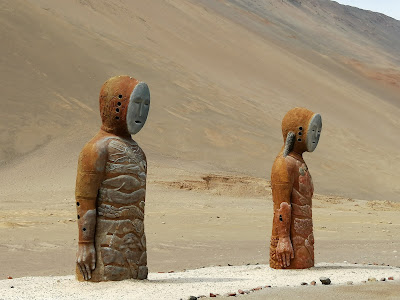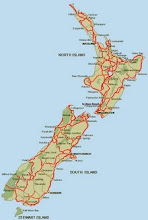Nienke found a bike rental 2 blocks away and we hired the bikes for the day, opting to cycle to Coquimbo. We clearly hadn't used a bike for a while as within half an hour we were in Coquimbo. What to do with the bikes the rest of the day? Well, we parked them at the beach, the coffee shop and the sushi restaurant.
English pirates were wreaking havoc in Coquimbo in the 16 and 17th century. Friends of us mistakenly told us Dutch pirates briefly occupied the castle here, but that was in Valdivia. No wonder we did not see any Dutch flags. It was actually Sir Francis Drake, an English pirate, who was guilty of the atrocities our peaceful nation was accused of (among others, bombarding La Serena). I discovered only one English flag between the plastic pirate swords, poorly decorated pirate ships with loud samba music coming from huge speakers and as pirates dressed people trying to lure us into their restaurants or hardly attractive pirate ships.
With a sad feeling we left La Serena and our new friends Jose and Ricardo behind. Onward to the Pisco Elqui valley. Pisco sour is a bit like Pavlova. For the Dutch readers, Pavlova is a ridiculously sweet meringue/whip cream treat the Australians and Kiwi's have been fighting over for ages. Was it a Kiwi or Aussie invention (I don't think there's a dentist who cares). The Peruvians and the Chileans have the same with pisco sour. Both claim to be the 'owner'. I think (being an amateur historian through many semi-convincing stories from pisco sour enthusiasts and pure nationalists) it has a Peruvian origin, but the Chileans perfected it. Let's hope my visa won't be withdrawn now.
We found the perfect camping spot in a remote valley, next to a fast flowing stream. Who needs more that a beer, a book and beautiful nature at the Rio Magico.
Pisco Elqui is a nice little town deep in the valley. You can get a massage, Reiki treatment or any other alternative therapy you can think of on any corner here. The town smells of incense and everybody appears to be happy.
Naturally it attracts the new generation of hippies with their nicely painted VW vans.
We skipped the visit to the Buddha estupa, the massage tables and hundreds of artesana shops and opted to read our books around a fire. We did however go to the nearby observatory to have a look at the stars. Because there is virtually no light pollution here the sky at night is amazing. In the morning I discovered 6 mosquito's in our tent. There was a hole in the ventilation net of our tent big enough to let them through. Must have escaped the Chinese quality check officer, or maybe he used to work at Huawei and was used to leaving a 'back door' in their products. Anyway, after killing the bastards my hands were covered with my blood, I'd been an unwilling donor again.
Had a nice wine tasting at an organic winery and managed to squeeze a box of wine into our already pretty full car. Every valley here is covered with vines, not only for the famous pisco sour, but also for a variety of nice wines.

From the wine valley we took a shortcut through the mountains. One of the first traffic signs made us very optimistic, probably not a lot of other traffic on the road.. We did not need Dutch courage after our earlier escapades, by now we're not afraid of anything anymore. Needless to say, it was a breeze!
On the other side we had a nice lunch in a beautiful hacienda, but after that roadworks prevented us from reaching the coast that day. Of the 25 road workers here, 3 were actually doing something. It may not surprise you we had to wait 30 minutes here. The roading manager sitting next to me was itching to tell them how to plan things better.
So we stranded on a nice camping close to the 'Valle del encanto'. This is a magical place where hunters and shepherds camped along a small stream some 4000 years ago. In the valley you could still find a lot of evidence of their presence. Petroglypes, pictographs, and tacitas (mortars). Here Nienke is standing at a bath, chiseled out in the rocks.
This stone shows a head with things suggesting ornaments or tiara hair dressings.
Unfortunately the stone surfaces have deteriorated a bit over time and many petroglyph's have been lost. Also layers of stone that were exposed to the elements have come of and with it the 'astronauts'. Some people still believe these people were visited by aliens and
that these primitive drawings were actually aliens. Like Dan Brown is his fantastic book 'Origin' (recommended) says, it's difficult to imagine that if there is intelligent life somewhere else in space, advanced enough to visit our Blue planet, would they be interested in just
saying 'hello' to a few hunters or probing some poor American farmers rectums (as they themselves claim). The petroglyph's are just drawings by ancient hunters and farmers who had nothing else to do. Nevertheless, after so many years, very interesting.
As we were very early we drove through a few small coastal towns. In this little we found this strange setting without any explanation.I guess the local 'alcalde' (mayor) had always been very fond of rhinoceroses but as they were sold out he settled for an elephant. Thinking it was a mammoth he added some prehistoric hunting stuff and .... OK, I can't explain the fish. Well, actually it's the only thing I can explain in this fishing village.
In Horcon we found another nice camping. Camping's here often have shade sails, tables and barbies. Good idea for NZ. Unfortunately we did have neighbours here. One started deflating his huge air mattress at 7 am, with his car-decompressor. The other side had to make phone calls early in the morning. For some reason here you have to say 'hello, hello, hello' (repeat 20 times) before you can start talking. Meanwhile about 20 tiny cats were rummaging our stuff for left overs.
Horcon was a small fishing village with again a hippie atmosphere. I think we were the only foreigners here. A rather scruffy looking figure immediately singled us out and offered us some joints. Again artesanas everywhere.
A small ceremonial bridge on the beach was covered with ribbons with messages or wishes that people tied to the bridge. A colourful display.
We found a more quiet beach a few km's down the road after descending a scary 100 m. staircase. Rewarding though.
In Concon we saw these funny birds who appear to have side-burns.
While we were having our coffees on the deck of a nice restaurant and pelican came checking us out. Pretty nosey, although when I asked her to sit still she turned out to be a bit shy.
Chile looks a bit like NZ, apparently more so down south. But here in Concon we found seals frolicking on the rocks and in the water like it was the seal colony at Cape Palliser.
Had a quick lunch (empenada of course) on the beach in Vina del Mar where it was busier than in Scheveningen on a hot summers day.
Road safety is not taken very seriously here in Chile. We saw this guy on the road, no hood, no doors, several other parts missing and the police (very present everywhere in Chile) just let him drive on. Drivers themselves are to blame as well. No one is wearing a seat belt (especially not the heirs on the backseat) and just like in NZ almost no one uses their indicating lights, very afraid they might wear prematurely.
We found a small hostal in Vina la Mar with a ridiculous parking, a 45 degrees ramp of 20 meters and then 6 cars parked in a small place like a tetris game. The place was like a maze and they gave us a bunch of keys a jailer should be jealous of. We were still left with one door that couldn't be locked....
In Vina del Mar we met the family of Nienkes Chilean aunt. An absolutely great family who made us feel so welcome. Cultural differences: initially there was a bit of confusion over the Whatsapp which was actually quite funny. Nienke messaged that we would bring some wine to which Mario Claudio reacted that they did not drink wine with tea. Tea in NZ means dinner (and tea in the afternoon afternoon-tea). Not very logical indeed. Anyway, Mario Claudio texted back we were going to have 'once'. We thought it's quite odd to have dinner at 11 pm, but we are on a holiday and in Chile they have dinner late.
'Once' turned out not to be late evening dinner. 'Once' means evening snacks in Chile. We had a great evening and hope to see these lovely people again in the future.
From Vina del Mar we drove south to Pichelemu, surfers paradise, where we met Coco and Jirka, our friends from Santiago, again. Jirka will accompany us for a few days to Santa Cruz, the famous wine area of Chile and tow national parks for some serious hiking.
Cheers to you all!





































































_+Lucky+shot+bij+Whangaroa.jpg)